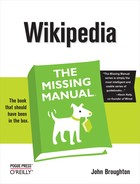If an article doesn’t have sources, it’s pointless to spend a lot of time working on the organization or writing. The article may get deleted for lack of reliable sources, so you may be just rearranging junk in a garage so it looks aesthetically pleasing. Instead, devote your time to finding sources. If an article has little content, you need sources that provide more content. If an article has lots of unsourced statements, you need to find sources to do one of three things:
Support those statements, so you can keep them in.
Contradict those statements, so you have justification to delete them (by adding cited information that says the opposite).
Provide enough new content to supplant those statements, so you can move them to the article talk page, and invite others to add them back when they find sources.
Chapter 2 discussed how to add content, and listed a number of places on Wikipedia that can help you find it. Here are some additional considerations to think about as you look for and add content:
Don’t just use a search engine. There are lots of places to find sources. Chapter 4, on new articles, has a comprehensive list (Resources for Writing Articles). Most good articles aren’t built just by using a search engine like Google. Among the most valuable sources are online databases of articles available through schools and libraries.
Edit one section at a time, not the entire article, if you anticipate objections. If there’s any possibility that other editors who have worked on the article in the past few months may have concerns about your edits, you’ll make their lives much easier if you edit section by section. They’ll also be less inclined to object if they see what you’re doing, which means taking an organized, methodical approach. It’s also easier if editors can discuss objections in the context of a section, not the whole article.
Alternatively, you can copy the information in one section to another place (a subpage of yours, or totally off Wikipedia), edit it there, and then bring it in as a new chunk of information.
Note
For articles with lots of editing ongoing by other editors, working on a copy of a section usually isn’t a good approach. When you plop down your new version of that section, you overwrite anything that happened since you made your copy. So restrict this approach to articles that are relatively orphaned, where you’re not competing with other editors who are constantly changing information.
Stay on topic. The most readable articles contain no irrelevant or only loosely relevant information. While writing an article, you might find yourself digressing into a side subject. If you find yourself wandering off-topic, consider placing the additional information into a different article, where it fits more closely with the topic. If you provide a link to the other article, readers who are interested in the side topic have the option of digging into it, but readers who are not interested won’t be distracted by it.
Don’t use a huge percentage of material from a single source as content for an article. For example, don’t add more than five to 15 percent of the information in a single source (like a newspaper article) to a Wikipedia article. Don’t have 90 percent of the information in a Wikipedia article come from a single book.
If you find yourself struggling with this issue, reconsider how notable the subject is, and whether a really long article is appropriate. For some subjects, you can say everything important in less than 10 or 15 paragraphs. Or you may decide that you’re going to have to dig deeper into the resources available to you—ask your local library to order for you some books not in its collection, or go online at the library to get to specialized collections.
Keep length and balance in mind. If a section gets too long, split it into subsections. If it becomes clear from the sources you’re using that a particular aspect of the article is notable in its own right (because you keep finding good content), spin that off as its own article (see “Don’t Take Article Scope as a Given” on Don’t Take Article Scope as a Given), rather than bulking out a section or pruning it back severely to fit with the rest of the article.
If you’re an expert, avoid temptations. You know this stuff cold, so you don’t really need sources, right? Wrong. Yes, it’s tedious to look up things you learned 20 years ago, but things may have changed since then. In any case, remember that the goal of Wikipedia isn’t to contain all human knowledge—it’s to provide a starting point for readers, to get them interested enough in the topic that they’ll consider reading the cited sources as well. They can’t go get more information if you don’t tell them where they can do so. And, as a bonus, if you cite your sources, other editors don’t have to rely on your word that you’re an expert.
A second temptation is to cite your published writings as a source. That’s considered by many editors to be a violation of Wikipedia’s conflict of interest guideline (see WP:COI for details). It puts you into the awkward position of having to judge whether your own work is a reliable source. (Is the publication peer-reviewed? Is that small publisher really anything other than a vanity press?)
If a section, when you’re done with it, is clearly superior in terms of the amount of information and the number of sources cited, you’re much less likely to run into opposition. Well-documented information is the nirvana of Wikipedia. It’s also wonderful point-of-view-repellent when other editors have strong opinions about a subject.
